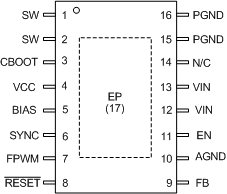SNVSA42B June 2015 – May 2016 LM53602-Q1 , LM53603-Q1
PRODUCTION DATA.
- 1 Features
- 2 Applications
- 3 Description
- 4 Revision History
- 5 Device Comparison Table
- 6 Pin Configuration and Functions
- 7 Specifications
- 8 Detailed Description
- 9 Application and Implementation
- 10Power Supply Recommendations
- 11Layout
- 12Device and Documentation Support
- 13Mechanical, Packaging, and Orderable Information
6 Pin Configuration and Functions
PWP Package
16-Lead HTSSOP
Top View

Pin Functions
| PIN | I/O(1) | DESCRIPTION | |
|---|---|---|---|
| NAME | NO. | ||
| SW | 1,2 | P | Regulator switch node. Connect to power inductor. Connect pins 1 and 2 directly together at the PCB. |
| CBOOT | 3 | P | Bootstrap supply input for gate drivers. Connect a high quality 470 nF capacitor from this pin to SW. |
| VCC | 4 | O | Internal 3.15 V regulator output. Used as supply to internal control circuits. Do not connect to any external loads. Can be used as logic supply for control inputs. Connect a high quality 3.3 µF capacitor from this pin to GND. |
| BIAS | 5 | P | Input to internal voltage regulator. Connect to output voltage point. Do not ground. Connect a high quality 0.1 µF capacitor from this pin to GND. |
| SYNC | 6 | I | Synchronization input to regulator. Used to synchronize the regulator switching frequency to the system clock. When not used connect to GND; do not float. |
| FPWM | 7 | I | Mode control input to regulator. High = forced PWM (FPWM). Low = auto mode; automatic transition between PFM and PWM. Do not float. |
| RESET | 8 | O | Open drain reset output. Connect to suitable voltage supply through a current limiting resistor. High = power OK. Low = fault. RESET will go low when EN = low. |
| FB | 9 | I | Feedback input to regulator. Connect to output voltage sense point for fixed 5 V and 3.3 V output. Connect to feedback divider tap point for ADJ option. Do not float or ground. |
| AGND | 10 | G | Analog ground for regulator and system. All electrical parameters are measured with respect to this pin. Connect to EP and PGND on PCB. |
| EN | 11 | I | Enable input to the regulator. High = ON. Low = OFF. Can be connected directly to VIN. Do not float. |
| VIN | 12, 13 | P | Input supply to the regulator. Connect a high quality bypass capacitor(s) from this pin to PGND. Connect pins 12 and 13 directly together at the PCB. |
| N/C | 14 | - | This pin has no connection to the device. |
| PGND | 15, 16 | G | Power ground to internal low side MOSFET. Connect to AGND and system ground. Connect pins 15 and 16 directly together at the PCB. |
| EP | 17 | G | Exposed die attach paddle. Connect to ground plane for adequate heat sinking and noise reduction. |
(1) O = Output, I = Input, G = Ground, P = Power